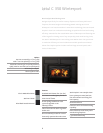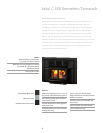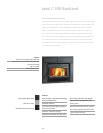
12
Burning the right wood
Many factors play a part when it comes to the overall quality of the wood
you burn. All wood, regardless of the species, has about the same energy content
per pound. The different species vary only in density. The more dense a
species of wood is, the greater the heat value or BTUs created per cord.
Hard wood (oak, maple) will burn longer and produce more heat than softer
woods (pine, birch). Ultimately it is more important to have wood that is cut,
split, stacked and dried properly than it is to get the hardest wood available.
Seasoning or drying your wood prior to burning is a key ingredient to
a high efficiency, low emissions fire. Depending on the species,
wood should be cut, split and allowed to dry under cover for 6 months
to two years.
Clean Burn Technology
Volatile gases are released from wood as it burns. Fifty percent of wood’s heat
value is contained in these gases and, if not completely burned, they contribute
to air pollution. By burning well seasoned wood, and utilizing Jøtul’s clean burn
technology, you greatly reduce smoke emissions while increasing your stove or
insert’s efficiency.
Benets of burning wood
94572_New_WoodInserts.indd 12 8/30/07 12:43:51 PM


















